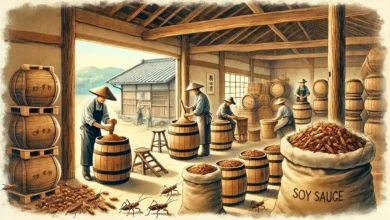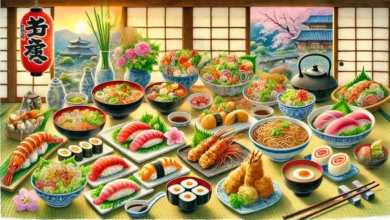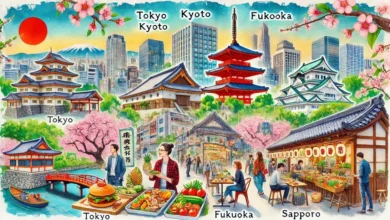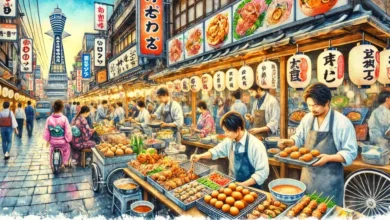Best Non-Sushi Dishes in Japan
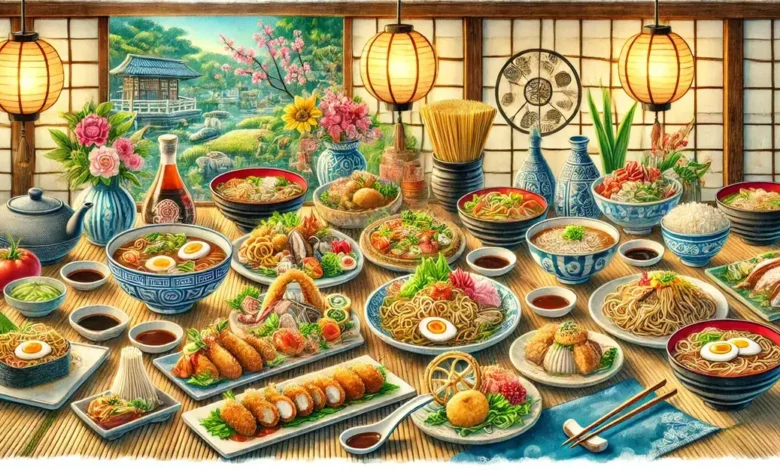
Japanese cuisine has a lot more to offer than sliced raw fish to the rest of the globe. With its moderate temperature and plentiful rainfall, this island nation is able to raise most of its own food, resulting in delectable and distinct Japanese dishes. The following is a list of the best non-Sushi dishes in Japan.
Okonomiyaki
Okonomiyaki is a big, tasty pancake. People cook it on a flat grill. Usually, it’s made with cabbage or other crunchy veggies. But, you can ask for a thinner one if you like. You can also add any toppings you want.
In an Okonomiyaki restaurant, you get to make your own dish right at your table. This is because ‘okonomi’ means ‘what you want’. So, you can choose what goes into your pancake. It’s a fun and delicious way to enjoy a meal. You can try different combinations each time. This way, you get to eat something new every time you visit.

Izakaya Fare
Izakaya, or Japanese bars, are great places to taste real Japanese food. You can order lots of different dishes there. Some are traditional, like yakitori, which are grilled chicken skewers, and grilled salmon. Others are more modern, like bacon-wrapped Enoki mushrooms and stew.
The best part is, you can drink sake or beer with your food. These drinks are often made by local brewers. The dishes are small, so you might need to order a lot to feel full. But that’s okay. It gives you a chance to try many different foods.

Takoyaki
Takoyaki is a popular food in Japan. It’s made from pieces of octopus that are dipped in batter and then cooked. The word ‘yaki’ means ‘grilled’, so Takoyaki means ‘grilled octopus’.
You can often find Takoyaki at street food stalls, especially during festivals. They’re usually served in large amounts, perfect for sharing with friends or family. Instead of using chopsticks, people eat Takoyaki with toothpicks. It’s a fun and tasty way to enjoy a meal. Osaka, a city in Japan, is famous for its Takoyaki. Many people say it’s the best in the country.

Unagi
Unagi is a Japanese word that means ‘eel’. People in Japan often cook Unagi by grilling it. They then put some sauce on top. It’s usually served over rice, in a dish called ‘unagi-don’. Many people consider it a special treat.
Eating Unagi at a restaurant can be a bit expensive, especially if you’re having a full dinner. But don’t worry, there’s a cheaper option. You can get an ‘unagi bento’. This is a boxed lunch set that also has Unagi. It’s just as delicious, but it costs less.

Dango
Dango is a type of Japanese food. It’s made from sticky rice dumplings, which are also known as mochi. Making Dango by hand takes a lot of work. In the past, people only made it for special times like New Year’s.
But now, you can buy Dango almost anywhere. You can find it in convenience stores or from sellers on festival days. Dango can be cooked on a grill. It can taste savory, which means not sweet, or it can be a little sweet.
Dango is a big part of Japanese culture. You might have seen the colorful hanami dango. It has three colors and is a symbol of spring in Japan. Even though Dango is a dessert, it’s not as sweet as you might think.

Rāmen (MY Best Non-Sushi Dishes)
Ramen is a type of noodle dish that comes from China. It’s made with soft, fresh noodles that are cooked in a broth made from meat. The noodles are then topped with vegetables and pork. You’ll often find spring onions, thin slices of pork, and soft-boiled eggs added to it.
When you eat Ramen, you use chopsticks and a special soup spoon. This way, you can sip the broth without having to lift the bowl. It’s a fun and tasty way to enjoy a meal.
Udon is another type of noodle dish. It’s similar to Ramen, but there are some differences. Udon noodles are much thicker than Ramen noodles. Also, the broth in Udon is lighter than the one in Ramen.

Soba
Soba is a type of noodle from Japan. It’s made from buckwheat, which makes it hearty and chewy. Some people even say it’s healthier than noodles made from wheat.
In the summer, people like to eat Soba cold. They dip the noodles in a special sauce instead of eating them in hot soup. This is called ‘zaru soba’. It’s a cool and tasty way to enjoy a meal when it’s hot outside. If you’re ever in Tokyo, you should visit the Asakusa neighborhood. There, you’ll find lots of places that serve delicious Soba.

Tonkatsu (MY Best Non-Sushi Dishes)
Tonkatsu is a dish from Japan. It’s made from pork cutlets that are breaded and deep-fried. It’s usually served as part of a meal set. This includes soup, pickles, rice, and other side dishes.
You can find Tonkatsu in many places. Some restaurants specialize in making it. You can also find it in bento boxes at grocery stores. Another place to find Tonkatsu is at ‘shokudo’. These are eateries that are easy to find and not too expensive.
Shokudo often have plastic models of their meals displayed out front. This way, you can see what the food looks like before you order. You can find shokudo near malls, tourist spots, and train stations.

Kaiseki
Kaiseki is a special kind of food from Japan. It’s considered gourmet, which means it’s very fancy and delicious. When you eat Kaiseki, it’s like a feast for all your senses.
You can find Kaiseki at fancy Japanese restaurants called ‘ryotei’. These meals are served in private rooms. But, they can be quite expensive. A meal can cost more than 10,000 yen per person.
But don’t worry, there’s a way to try Kaiseki without spending too much. Many Kaiseki restaurants offer a sample of their food during lunch. This is served in a ‘bento’, which is a type of lunch box.


